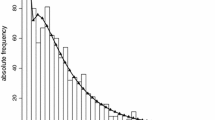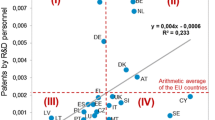Abstract
The potential occurrence of variable returns to size in research activity is a factor to be considered in choices about the size of research organizations and also in the planning of national research assessment exercises, so as to avoid favoring those organizations that would benefit from such occurrence. The aim of the current work is to improve on weaknesses in past inquiries concerning returns to size through application of a research productivity measurement methodology that is more accurate and robust. The method involves field-standardized measurements that are free of the typical distortions of aggregate measurement by discipline or organization. The analysis is conducted for 183 hard science fields in all 77 Italian universities (time period 2004–2008) and allows detection of potential differences by field.




Similar content being viewed by others
Notes
As an example of such style, Italy’s Triennial Research Evaluation exercise (2001–2003) subdivided research organizations into three groups based on size of their research staff (VTR 2006).
Local regression (i.e. non-linear) method.
Since MIUR financing composes 55.5% of the total, the share distributed on the basis of the VTR represents 3.9% of total income.
The complete list is accessible on http://cercauniversita.cineca.it/php5/settori/index.php. Last accessed on July 20, 2011.
http://cercauniversita.cineca.it/php5/docenti/cerca.php. Last accessed on July 20, 2011.
www.orp.researchvalue.it. Last accessed on July 20, 2011.
In the Italian academic system, the hard sciences are matched in nine UDAs: mathematics and computer sciences; physics; chemistry; earth sciences; biology; medicine; agricultural and veterinary sciences; civil engineering; industrial and information engineering.
Observed as of June 30, 2009.
Standardizing citations to the median value rather than to the average, as frequently observed in literature, is justified by the fact that distribution of citations is highly skewed (Lundberg 2007).
The average number of publications per year by a physicist is 2.3 times what a mathematician produces.
Although members of the same SDS may publish in different WoS subject categories their publication rate is not greatly affected by this. Differences in SS continue to reflect differences in productivity.
Because in the life sciences, the different position in the authors’ list of publications reflects the different contribution of the authors to the work, the following algorithm has been proposed by Italian scientists in the life sciences. It can be adapted to reflect different national contexts. If first and last authors belong to the same university, 40% of citations are attributed to each of them; the remaining 20% are divided among all other authors. If the first two and last two authors belong to different universities, 30% of citations are attributed to first and last authors; 15% of citations are attributed to second and last author but one; the remaining 10% are divided among all others. This algorithm has been proposed by Italian scientists in the life sciences. It can be adapted to reflect different national contexts.
With individual top scientists defined as those positioning above 80th percentile of national performance, a value of “top scientists” greater than 20% at a university indicates that their percentage in the staff is higher than the national average.
Kendall’s τb assumes values between −1 (perfect inversion) and +1 (perfect concordance), with a value of 0 in cases of absence of association.
DEA methodology seems particularly suited to comparing efficiency of research institutions, especially with the increasing availability of quantitative indicators for input and output. Abramo et al. (2011b) is an example of a field-standardized application to national assessment.
References
Abbott, M., & Doucouliagos, C. (2003). The efficiency of Australian universities: A data envelopment analysis. Economics of Education Review, 22, 89–97.
Abramo, G., Cicero, T., & D’Angelo, C. A. (2011a). The dangers of performance-based research funding in non-competitive higher education systems. Scientometrics (forthcoming). doi:10.1007/s11192-011-0355-4.
Abramo, G., Cicero, T., & D’Angelo, C. A. (2011b). A field-standardized application of DEA to national-scale research assessment. Journal of Informetrics (forthcoming). doi:10.1016/j.joi.2011.06.001.
Abramo, G., D’Angelo, C. A., & Caprasecca, A. (2009). Allocative efficiency in public research funding: Can bibliometrics help? Research Policy, 38(1), 206–215.
Abramo, G., D’Angelo, C. A., & Di Costa, F. (2008). Assessment of sectoral aggregation distortion in research productivity measurements. Research Evaluation, 17(2), 111–121.
Adams, J., Black, G., Clemmons, R., & Stephan, P. (2005). Scientific teams and institutional collaborations: Evidence from U.S. universities, 1981–1999. Research Policy, 34(3), 259–286.
Adams, J. D., & Griliches, Z. (1998). Research productivity in a system of universities. Annales d’economie et de statistique, 49/50.
Avrikan, N. K. (2001). Investigating technical and scale efficiencies of Australian Universities through data envelopment analysis. Socio-Economic Planning Sciences, 35, 57–80.
Bonaccorsi, A., & Daraio, C. (2005). Exploring size and agglomeration effects on public research productivity. Scientometrics, 63(1), 87–120.
Cohn, E., Rhine, S. L. W., & Santos, M. C. (1989). Institutions of higher education as multi-product firms: Economies of scale and scope. The Review of Economics and Statistics, 71(2), 284–290.
D’Angelo, C. A., Giuffrida, C., & Abramo, G. (2010). A heuristic approach to author name disambiguation in large-scale bibliometric databases. Journal of the American Society for Information Science and Technology, 62(2), 257–269.
Dundar, H., & Lewis, D. R. (1995). Departmental productivity in American Universities: Economies of scale and scope. Economics of Education Review, 14(2), 119–144.
Dutch-Brown, N., Parellada-Sabata, M., & Polo-Otero, J. (2010). Economies of scale and scope of university research and technology transfer: a flexible multi-product approach. Document de treball de Barcelona Institute of Economics, 2010/51.
Glänzel, W. (2008). Seven myths in bibliometrics. About facts and fiction in quantitative science studies. In H. Kretschmer & F. Havemann (eds) Proceedings of WIS fourth international conference on webometrics, informetrics and scientometrics & ninth COLLNET meeting, Berlin, Germany.
Golden, J., & Carstensen, F. V. (1992). Academic research productivity, department size and organization: Further results, comment. Economics of Education Review, 11(2), 169–171.
Hara, N., Solomon, P., Kim, S. L., & Sonnenwald, D. H. (2003). An emerging view of scientific collaboration: Scientists’ perspectives on collaboration and factors that impact collaboration. Journal of the American Society for Information Science and Technology, 54(10), 952–965.
Hashimoto, K., & Cohn, E. (1997). Economies of scale and scope in Japanese private universities. Education Economics, 5, 107–115.
Izadi, H., Johnes, G., Oskrochi, R., & Crouchley, R. (2002). Stochastic frontier estimation of a CES cost function: The case of higher education in Britain. Economics of Education Review, 21, 63–71.
Jordan, J., Meador, M., & Walters, S. J. K. (1988). Effects of department size and organization on the research productivity of academic economists. Economics of Education Review, 7(2), 251–255.
Jordan, J., Meador, M., & Walters, S. J. K. (1989). Academic research productivity, department size and organization: Further results. Economics of Education Review, 8(4), 345–352.
Koshal, R. K., & Koshal, M. (1999). Economies of scale and scope in higher education: A case of comprehensive universities. Economics of Education Review, 18, 269–277.
Laband, D. N., & Lentz, B. F. (2003). New estimates of economies of scale and scope in higher education. Southern Economic Journal, 70, 172–183.
Lewis, D., & Dundar, H. (1999). Cost productivity in higher education: Theory, evidence, and policy implications. In J. Smarth (Eds.), Higher education: Handbook of theory and research. Agathon Press, NY. ISBN: 0-87586-125-3.
Longlong, H., Fengliang, L., & Weifang, M. (2009). Multi-product total cost functions for higher education: The case of Chinese research universities. Economics of Education Review, 28, 505–511.
Lundberg, J. (2007). Lifting the crown-citation z-score. Journal of Informetrics, 1(2), 145–154.
Moed, H. F. (2005). Citation analysis in research evaluation. Dordrecht, The Netherlands: Springer.
Moed, H. F., Glänzel, W., & Schmoch, U. (2004). Handbook of quantitative science and technology research: The use of publication and patent statistics in studies of S & T systems. Berlin: Springer.
Newell, A., & Sproull, R. F. (1982). Computer networks: Prospects for scientists. Science, 215(4534), 843–852.
Seglen, P. O., & Asknes, D. G. (2000). Scientific productivity and group size: A bibliometric analysis of Norwegian microbiological research. Scientometrics, 49(1), 123–143.
VTR. (2006). Italian triennial research evaluation. VTR 2001–2003. Risultati delle valutazioni dei Panel di Area. http://vtr2006.cineca.it/index_EN.html. Last accessed 20 July 2011.
Wagner, C. S., & Leydesdorff, L. (2005). Network structure, self-organization and the growth of international collaboration in science. Research Policy, 34(10), 1608–1618.
Williams, D. A. (1976). Improved likelihood ratio tests for complete contingency tables. Biometrika, 63(1), 33–37.
Worthington, A. C., & Higgs, H. (2011). Economies of scale and scope in Australian higher education. Higher Education, 61(4), 387–414. doi:10.1007/s10734-010-9337-3.
Zitt, M., & Bassecoulard, E. (2004). S&T networks and bibliometrics: The case of international scientific collaboration. 4th Proximity congress: Proximity, networks and co-ordination, Marseille, France, June 17–18, 2004, p 15.
Author information
Authors and Affiliations
Corresponding author
Rights and permissions
About this article
Cite this article
Abramo, G., Cicero, T. & D’Angelo, C.A. Revisiting size effects in higher education research productivity. High Educ 63, 701–717 (2012). https://doi.org/10.1007/s10734-011-9471-6
Published:
Issue Date:
DOI: https://doi.org/10.1007/s10734-011-9471-6




